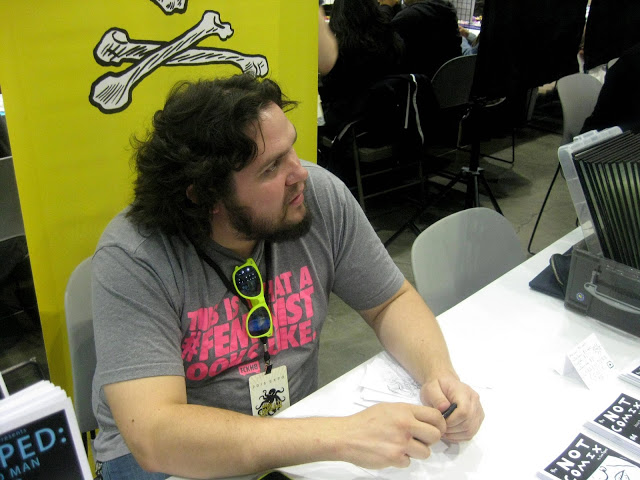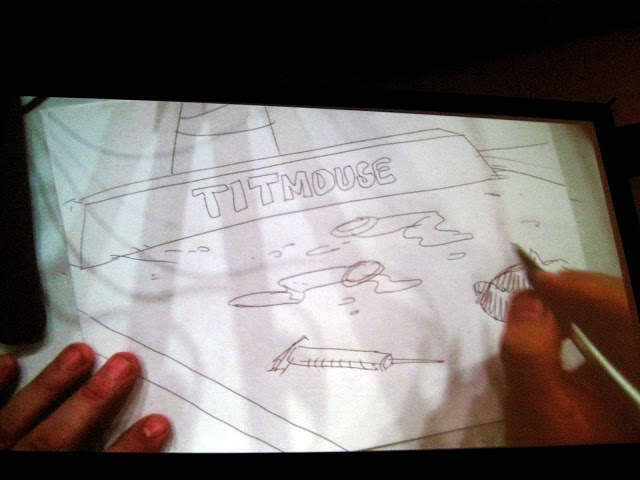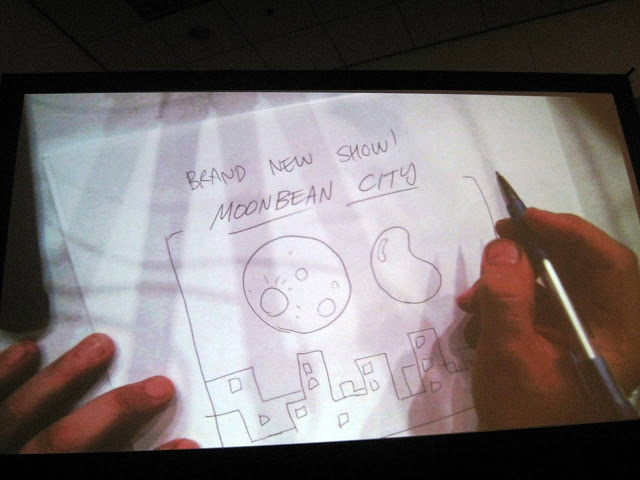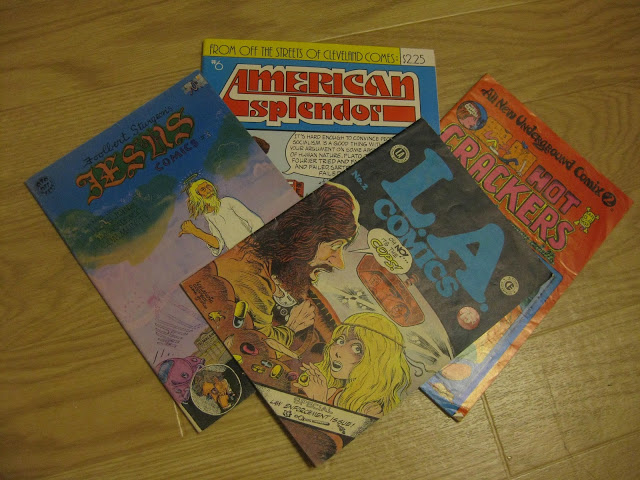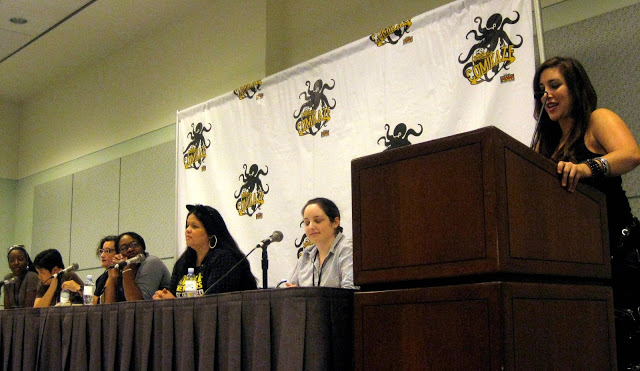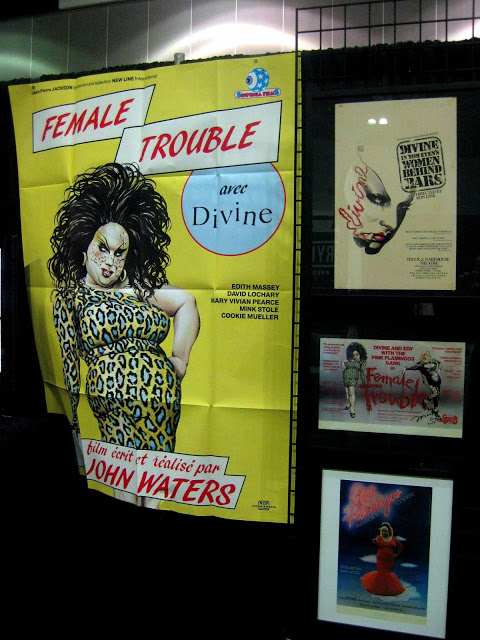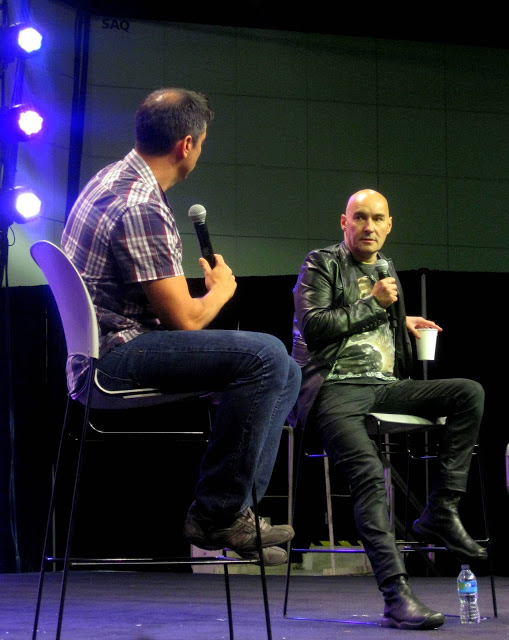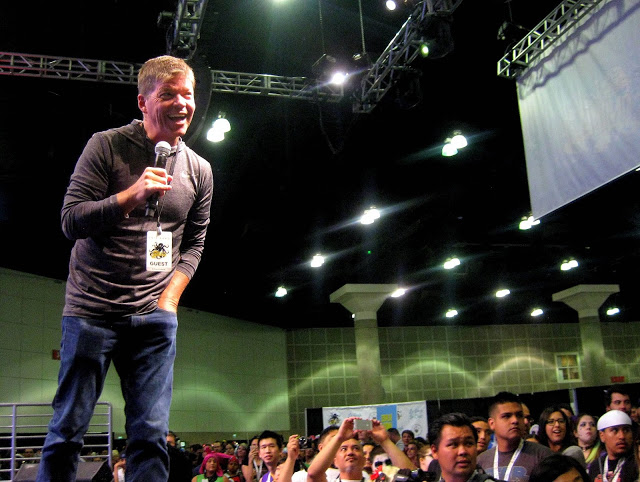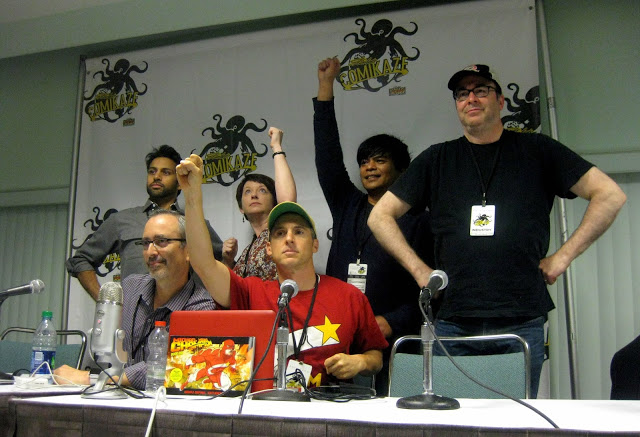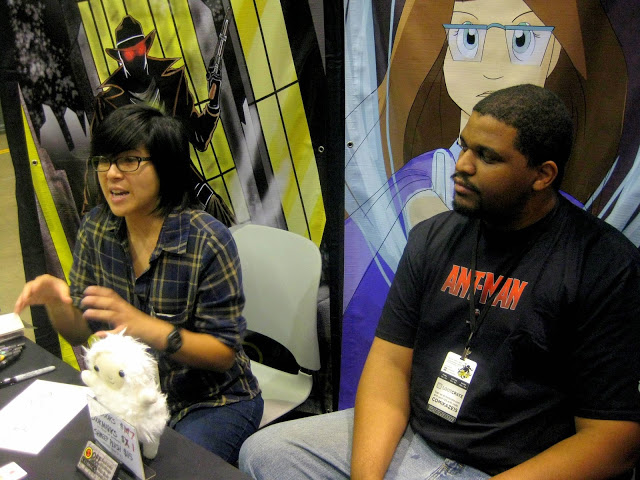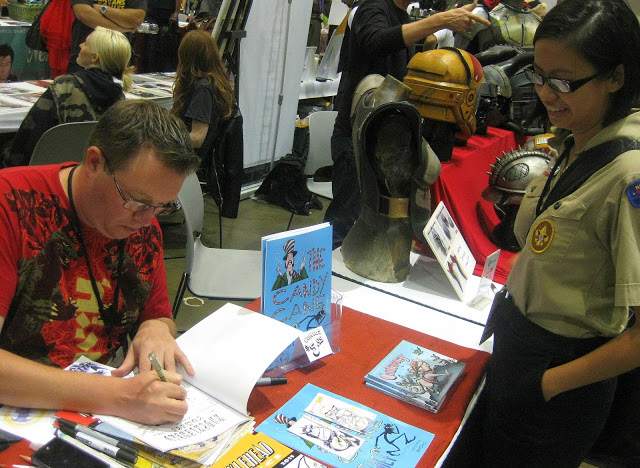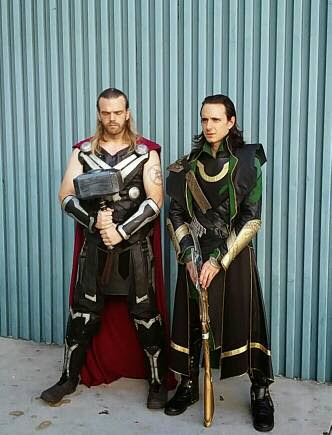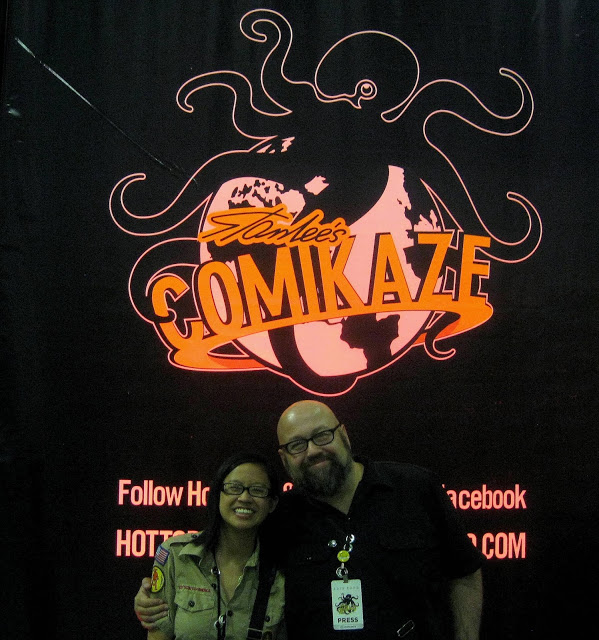 |
| Written by Lily and Generoso Fierro |
NOTE: This article will refer to “comic books” as “comicbooks,” per Stan Lee’s preferred nomenclature that he described in the Legends Of Comics Panel at Comikaze 2015.
From the works we review, it is probably readily apparent that we do not focus too heavily on the DC and the Marvel Universes of comicbooks and media. This in no way means that we’re not interested in them; in fact, the recent reboot of Marvel’s Hawkeye spurred Lily’s fascination with comics, and Generoso worshiped Captain America and Spider-Man as a boy.
Consequently, when we attended Stan Lee’s Comikaze over the weekend, we had a constant internal struggle between our love for major pop culture and our devotion to the independent and the underground.
Previously, when we attended Long Beach Comic Con 2015, we focused most of our coverage on the independent voices of Artist Alley. With the lineup of Comikaze offering plenty of educational panels, a vast Artist Alley, and a main stage that featured discussions with some of the major players in entertainment and geekdom, a battle between our fascination with both the popular and the esoteric swelled, and we tried our best to satisfy both parties over the course of three days.
From the first moment of our arrival to the Los Angeles Convention Center on Friday, the first day of Comikaze, we descended upon Artist Alley and the small press aisle of the West Hall exhibition floor, where to our good fortune, we first met Evan Spears, creator of the sketchbook series Not Comix and illustrator of Scrapped: The Dead Man.
Not Comix chronologically collects daily sketches, which are interesting in experimentation but primarily serve to showcase his technical skill and imagination as an illustrator. On the other hand, his collaboration with James Mitchell, who wrote Scrapped: The Dead Man, was incredibly fruitful; Mitchell creates a funny, absurd, and existential narrative, and Spears creates characters and sparse settings to match. Scrapped questions the concepts of free will and reincarnation in very few pages with a fun and loose spirit; it was an excellent early find.
As we continued our survey of Artist Alley and weaved through seemingly endless rows of craft stands with bow ties, candles, headbands, and buttons, we were almost blinded by the staggering amount of tchotchkes to the point that we almost bypassed Jose Pimienta’s table.
Jose was the illustrator of one of Lily’s favorite graphic novels that she read and reviewed this year, The Leg, written by Van Jensen and released by Blue Creek Creative in 2014, and to our luck, he had copies of the book with its bright and distinctive cover at the edge of his table, which lured us right over. Since the floor had just opened and had not yet filled with the massive crowds that would make it a bit louder and less navigable in the days to come, this moment provided us with that rare, wonderful opportunity to speak to a young creator in an appreciative way of a completed and published work.
When we arrived at the table, Jose was working on impressive sketches for a new venture, and after our quick burst of admiration for The Leg, Jose was kind enough to offer some wisdom about creating a consistent visual style in comicbooks to Generoso, who is working on illustrating our first attempt at an independent comic, and for that extended conversation about the process and the encouragement to just continue to create and practice, we are forever grateful. After the discussion about the illustration approach, we decided to pick up the outstandingly illustrated From Scratch, an older work published in 2010, which was a satisfying second pick.
Despite the success of our first discoveries, our curiosity for Stan Lee’s welcome forced us to cut our dwelling in the aisles of Artist Alley short in order to make our way toward the Hot Topic Main Stage of Comikaze in the South Hall of the convention center.
Predicting that a large crowd would form to hear the words of the almighty Stan Lee, we arrived early to the Main Stage, and to our surprise, we stumbled upon the boldly named, “Iron Shield Arms/Combat Stunt Consulting Superhero Showdown,” which was taking place. For the twenty minutes that they took the stage, the group displayed an array of movie and television simulated fighting techniques that, besides being informative, were incredibly entertaining to witness. It definitely made the wait before Stan far more enjoyable.
At 3:30 sharp, the king of the Marvel Universe, 93 year old, Stan Lee, who is still as sharp as ever welcomed the crowd at his self named convention.
This was our first time seeing Stan Lee in person, and, for Generoso, a devotee as a young man to the Marvel Universe and one of the rare people to enjoy his performance in the 1995 film Mallrats, it was a real joy to see him on stage with Director Hiroshi Nagahama and the team at Studio Deen to announce and promote their collaboration on The Reflection, a new animated series expected to premiere for Japanese television in the fall of 2016.
And based on the photograph below, Stan is not only excited about this project, but for any moments he can spend in the company of the Saki Miata, the moderator of the panel and collaborator on The Reflection.
After being awe-struck by Stan Lee and the impressive green glass sculpture of one of the characters of The Reflection, we returned to the depths of the independents with the “Story Worlds – Transmedia Workshop,” which was presented by the New York Film Academy.
This panel provided us with some of the most useful approaches for creating a narrative for television, film, or comicbooks as our panel, which morphed in size from 2 to 3, worked with audience members to develop and fine tune their ideas and concepts, going as far as changing the purposes of individual characters and time periods to create better consistency or changing the medium of the storytelling to account for the daunting restrictions of getting someone to produce a high budget television show or film feature.
Now, let’s not kid ourselves, there were many things on the schedule that jumped out at us in terms of panels, but none loomed greater than the panel closing our first day at Comikaze run by the creative forces of Titmouse, the animation studio behind a multitude of mentally depraved cartoons such as Metalocalypse, China, IL, Superjail!, and their newest venture, which currently airs on Comedy Central, the Will Forte and Rob Lowe voiced, 1980s neon spectacular, Moonbeam City. We queued up for this panel in a rather long line, which we will optimistically credit to the power of Titmouse productions and not the incentive of free shit, which they promised in the panel description.
The enthusiastic audience was immediately crushed with the news given by moderator Tommy Blacha (whom you may remember as the Gaseous Weiner on the early days of the original Conan O’Brien late night show or as the voice of Mr. Wongburger from the infamous “Dickesode” episode of Aqua Teen Hunger Force) that there would be no free shit, since they forgot to bring their swag.
Not to fear though; his artists on the panel feverishly riffed on any mistakes from audience questions or sad stories from the panel in the form of on-camera hand drawn cartoons that were dispensed to anyone who asked a question.
Our pity went out to the young woman who errantly titled Titmouse’s new show as “Moon-BEAN City” when she praised it. The following drawing, which resulted in the first of many hysterical outbursts from the audience, served to visually (and perpetually) remind her of her verbal mistake.
When another audience member gave his praise to their 2004 short-lived animated series Megas XLR, he was verbally and then visually reminded of the plethora of cancelled Titmouse productions as seen in this somewhat depressing but incredibly funny sketch of the Titmouse graveyard, complete with a floating, pizza eating specter.
On the second day of Comikaze, we woke up and arrived early to explore the exhibitor floor because, in the midst of all of the events, conventions are always a great opportunity to pick up trades and single issues of older comics, and here, we had the chance to dig for gems of the American comicbook underground and independent scenes of the 1970s and 1980s.
After digging through cardboard boxes and piles, we picked up a healthy handful of works that included treasures from the underground widely vacillating in content from sex to raunchier sex to drugs, as with the case of Hot Crackers and L.A. Comics, to the day to day activities of the thrifty poet-laureate from Cleveland, Ohio, as with the case of Harvey Pekar’s American Splendor (a series that Generoso is trying to piece back together because his original collection of Splendor was destroyed in a flood).
Given our finds of the morning, most of which pertained to the past and had content that could be considered questionable and offensive to women (though we’d argue otherwise), we were excited to attend the panel, “Beyond Babes and Bullets: Exploding the Strong Female Character,” to get a sense of how the course of female characters in comics and media has changed and how to improve on building female characters in storytelling.
Women in comics has been a buzz topic for the industry over the past couple of years upon the open discussions and criticism that many of the major comicbook franchises focus on only male heroes and villains, so we hoped that the panel, which included two academic scholars, would have an engaging and educational conversation about the subject.
Sadly, these hopes and desires were completely squelched, for the complete lack of moderation rendered a potentially insightful panel into a hair-salon on a Sunday complaint session. The group fixated on bashing stereotypes we already know, and they even treaded the line of alienating male members of the audience, making the entire experience regrettable because by focusing on all of the negative or shallow representations of women in media, the panel failed to convey to the audience how to address the problem of poor female representation by learning how to create strong female characters in modern media.
After the disappointment of the “Beyond Babes and Bullets” panel, we stumbled upon a small, virtually unattended display honoring Harris Glenn Milstead, better known as Divine, the famed drag queen of many John Waters’ films.
This modest collection, which was intended to promote an upcoming exhibit here in Los Angeles of the actor’s contribution to the world of cross dressing, contained many photos and pieces of memorabilia that came directly from Divine’s mother, Frances. In the midst of all the superheros and major franchises on display during the weekend, this small demonstration gave us the best example of how diverse a comicbook convention can be.
With a sea of scantily clad cosplayers in front of us, we soon made our way from the bright green astroturf of the Divine exhibit to the Main Stage to spend the next two hours listening to interviews with some of the largest names in comicbooks from the past and present.
Beginning with Grant Morrison, who talked about his favorite X-Men, his vision as the new editor of Heavy Metal (expect the first issue of the renovation in February or March of 2016) and his upcoming work on a comicbook about the artist Louis Wain, whose change in mental state is believed to be reflected over the course of his illustrations of cats, this lively conversation transitioned perfectly into the “Legends of Comics – Part One” panel that included Todd McFarlane, Marc Silvestri, Jim Lee, and a surprise member, Stan Lee himself. With Stan’s inclusion on the panel, the tone quickly switched into a Stan Lee love-in, which provided many moments of genuine, heartfelt humor.
Ending this block of comicbook heavy hitters would be Rob Liefeld, the controversial creator of Deadpool. Never in our years of attending conventions and conferences have we experienced a more frenetic speaker than Mr. Liefeld. He took it upon himself to address the usual criticisms of his artistic limitations and his defense of fellow controversial comicbook creator Frank Miller.
After defending himself from the allegations he brought up against himself, he brought forth the news that Marvel will be releasing his new book soon while simultaneously praising Ryan Reynolds’ performance in the upcoming Deadpool film. He also reminded everyone that the film is rated R for a reason, so remember, don’t get upset with him if you take your children to see it and feel that the content is inappropriate!
Sunday morning, the final day of Comikaze, began with an eleven o’clock panel entitled, “Asian Americans in the Media,” moderated by psychologist Billy San Juan, PsyD and included comic convention blogger Tony B. Kim and character artist Jennifer Sese.
The panel featured a frank discussion about Asians in media, specifically focusing on the negative characterizations of the past and the current crop of positive Asian characters and actors. What was to be admired about this panel was the open discussion of personal experiences about acculturation and working within media that consistently grew in size via the inclusion of audience questions and shared experiences.
Our last panel for Comikaze 2015 was the rigidly structured but no less entertaining panel, “Heroes, Villains, Faith, and the Messiah.” We rarely crowd around after a panel to wait to mug the speakers, but we had to extend our hand in appreciation to this panel’s moderator, Jordan P. Gorfinkel, the former editor of DC Comics. Jordan assembled a panel of media professionals from almost every conceivable faith to discuss not only the messianic character (E.T. is apparently a good example of the messianic character? Okay, we’ll buy it.) but also the role that faith plays in the decision making process of working in media.
Do not be fooled; though this may sound severe next to the Titmouse insanity, this was the most entertaining panel of the convention, ending with a sequence of rapid fire questions that provoked laughter and intelligent discussion, including our favorite question, “Sexiest Man of the Cloth: Stephen Collins in 7th Heaven, Paul Bettany in Priest, or Richard Chamberlain in The Thorn Birds?” It was a plus that the panelist, Leo Partible, agreed with us on Richard Chamberlain.
Post the enlightenment of the “Heroes, Villains, Faith, and the Messiah” panel, to fulfill a lifelong dream, we made our way back to the Hot Topic Main Stage one last time to hear Darryl Matthew McDaniels, D.M.C. from the legendary hip-hop group, Run-D.M.C., hype the newest edition of his D.M.C. (i.e. Darryl Makes Comics) series. There was absolutely zero fat content to his presentation; Darryl immediately addressed his lifelong love of comics and his desire to make one of his own in a universe where he is a teacher rather than a hip-hop legend.
If Rob Liefeld’s discussion was the most frenetic of the weekend, D.M.C.’s was by far the most efficient and surgically precise, and you even got a few moments of crowd-pleasing freestyle rap too!
Before we took our leave of Comikaze 2015, Lily suggested one final walk through Artist Alley not only to speak with “Asian Americans in Media” panelist, Jennifer Sese, but also to scour the floor to see if we missed anyone.
To find Jennifer Sese, we traveled to the Off Shoot Comics table, where we met her and writer David Clarke to discuss their collaboration on Sanctioned, their newest work about Margaret, a young magician on a mission to save the world with a group of unlikely heroes.
While the first issue has a wobbly start, by the end, Margaret’s mission and her partner, the talking book Grimore, emerge as strong elements of the series and show potential for the energy and the concepts of future issues.
In the final moments of our search, we stopped at the table of Meesimo and Ralph Miranda, lured in by the range of artwork they presented in front of them. Given our general penchant toward independent voices and creators, it was only suiting that we ended our Comikaze 2015 experience with them. From Meesimo, we picked up issue three of his Knucklehead Comics series, which focused on a story about an animator struggling with his reputation as the creator of a cute children’s comic strip.
While the plot is certainly not completely new when it comes to discussing creators’ questioning the validity of their legacy, issue three of Knucklehead distinguishes itself with a mix of experimental imagery and classic animation along with the adorable character, Lil’ Fopp.
And from Ralph Miranda, we grabbed Kilgore the Investor, a work of a 24-hour comic creation workshop about a defrosted barbarian conqueror who makes his way into Wall St., adding only a tightly drawn necktie to his loincloth and massive battle ax outfit as he attempts to succeed in a slightly more ruthless way than Gordon Gekko.
In addition to Kilgore, we also added four issues of Man Fighting Street to our Comikaze collection. Featuring an evolving visual style, with the first issue beginning with an oil painting-like sequence and the later issues featuring manga-esque fight sequences, in addition to a protagonist that is always hungry and looking for food, Man Fighting Street follows the travails of former model Drystan Stryker as he attempts to run basic human errands but continues to encounter villains along the way.
As with Long Beach Comic Con, Comikaze 2015 was a very well organized, well attended event that brought an emphasis to established properties within media while not completely ignoring the young talent in the small rows of Artist Alley. We were happy to hear that the tables in Artists Alley were free for comics creators and artists, which allowed them to interact with the crowd that the larger names attracted. We ourselves had more than a few moments where we both were in awe of the legendary talents that were brought to the Los Angeles Convention Center on these three days.
That aspect, especially the opportunity to be within a few feet of Stan Lee, will stay with us for sometime, and simultaneously, we are so glad to have been able to shake the hands of and speak one-on-one with some really fine, up-and-coming artists and writers.
We did not wait in any autograph or photo booth lines (or pay the fees!); we’re not putting down anyone who enjoys this, but it is really not our thing, though we completely understand it is a major part of most comic cons. As for cosplayers, whether you came to Comikaze dressed up like one of the many Deadpools or Harley Quinns we saw, the fact that the convention also fell on Halloween seemed to elevate the level of effort into many of the costumes, which always serve as accurate barometers of current tastes and trends in pop culture.
In weeks leading up to Comikaze, posters across the city advertised the event as, “The Comic Con of LA.” We will concede to the sheer immensity of what happens at the San Diego Comic Con; there is truly something for everyone at that particular convention with its equal display of film, television, comicbooks, and video games.
On the other end of the convention spectrum, we never expected Comikaze to be the Small Press Expo that takes place each fall in Bethesda, MD in terms of its commitment to the smaller, independent cartoonist.
Though smaller than San Diego Comic Con and more pop culture oriented than Small Press Expo, Comikaze, at its core, still very much focuses on comicbooks and the media properties associated with them, so as far as comicbooks are concerned, Comikaze did have something for everyone.




































































































